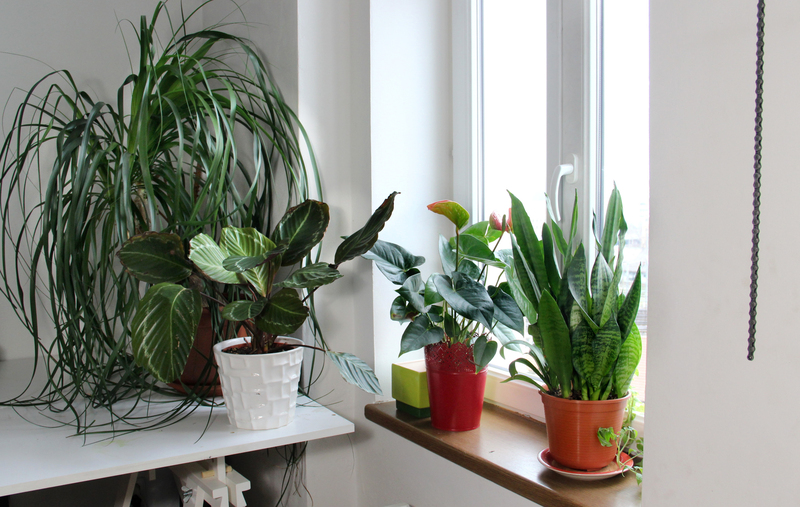Neglected Garden Transformation: Where to Begin
Posted on 28/05/2025
Neglected Garden Transformation: Where to Begin
Does your outdoor space resemble a wild, overgrown jungle rather than the inviting green oasis you dream of? Transforming a neglected garden may seem intimidating, but with the right approach, any dilapidated patch of land can be revitalized. In this comprehensive guide, we'll explore where to begin your garden renewal, focusing on actionable steps, expert tips, clever planning, and essential garden restoration strategies.

Why Neglected Gardens Need Attention
A forgotten garden is more than just an eyesore--it can attract pests, suffocate healthy plants, and even decrease property value. Undertaking a neglected garden transformation not only restores beauty but also promotes biodiversity, creates relaxing outdoor living spaces, and gives you a sense of accomplishment. Whether you aim to revive a private backyard, community plot, or inherited property, starting your garden revival journey can be transformative for both your landscape and your well-being.
Step-by-Step Neglected Garden Transformation
1. Assess and Visualize Your Space
Begin with a thorough assessment. Before picking up a shovel, spend time observing your neglected garden. Take photos, sketch a simple map, and note existing features--mature trees, sheds, hard landscaping, water taps, or shaded areas. Visualizing your space helps you spot potential design opportunities and features worth saving or integrating into your new garden transformation project.
- Identify positives: Are there mature shrubs, established trees, or hidden paths? These can serve as valuable assets in your new design.
- Spot challenges: Address invasive weeds, broken structures, or poor soil. These are issues you'll tackle early in the process.
- Sun and shade mapping: Observe where sunlight falls throughout the day. Knowing your garden's microclimates helps guide planting choices.
2. Declutter and Clean Up
Start transforming your neglected garden by clearing out debris, litter, and anything you no longer need. Cleaning and decluttering instantly provide a sense of progress and reveal the real potential of your outdoor space.
- Remove rubbish: Collect trash, broken pots, and garden furniture. Don't forget to check behind sheds or hidden corners.
- Prune overgrown plants: Cut back dead or invasive growth. Pruning doesn't just tidy up--it rejuvenates existing plants and encourages healthy regrowth.
- Recycle and donate: Consider giving away old planters or usable tools. Compost organic matter where possible.
3. Tackle Weeds and Reclaim Borders
Weeds are often the most overwhelming aspect of a neglected garden, competing with desirable plants and undermining aesthetics. Restoring your garden requires a focused weed management plan:
- Manual removal: For small plots, hand-pull weeds and their roots to prevent regrowth.
- Mulching: Apply a thick layer of mulch to suppress weed seeds and improve soil quality.
- Define borders: Use spades, half-moon edgers, or edging materials to clearly mark out beds and pathways.
4. Improve Soil Health
After years of neglect, soil often becomes compacted, depleted, or imbalanced. Healthy soil is the foundation of a flourishing garden restoration. Invest time in the following processes:
- Test your soil: Simple home test kits reveal pH and nutrient levels, informing fertilizer and amendment choices.
- Organic matter addition: Mix in compost, leaf mold, or well-rotted manure to boost fertility and drainage.
- Aerate compacted areas: Use a garden fork to break up hard ground and allow roots to penetrate more easily.
5. Plan Your Revived Garden Design
Now for the fun part--the creative stage! Once the space is cleared and healthy, visualize the future. Use your earlier observations to develop a basic garden design plan that balances practical needs with personal taste.
- Establish zones: Separate areas for relaxation, entertaining, food growing, or children's play.
- Choose easy-care features: Raised beds, gravel, or low-maintenance planting for long-term success.
- Incorporate wildlife habitats: Install bird feeders, bug hotels, or a pond to support local biodiversity.
6. Begin Planting for Impact
Select plants that suit your garden's conditions and your maintenance ambitions. As you restore your neglected backyard, opt for resilient perennials, fast-growing shrubs, or ground covers that outcompete weeds and instantly uplift the landscape.
- Native species: Local plants typically require less water and care, while supporting pollinators.
- Layering: Combine tall, medium, and low-growing plants for visual interest and year-round appeal.
- Instant color: Include seasonal annuals or bulbs for quick pops of brightness.
7. Restore Paths, Edges, and Structures
Good structure is the backbone of garden design. Refreshing paths, patios, fences, and sheds gives your renewed garden a cohesive character and increased functionality.
- Repair or clean existing features: Treat wooden fences and sheds to prevent rot, and power wash patios for a fresh look.
- Add new paths: Lay stepping stones or gravel walkways for access and definition.
- Upcycle materials: Use salvaged bricks or broken tiles creatively, saving money and reducing waste.
8. Mulch, Water, and Nurture
Completion of your garden transformation isn't the end--regular maintenance is key to ongoing success.
- Mulch: Retains moisture, keeps weed growth down, and insulates plant roots.
- Water effectively: Especially in the early stages, deep but infrequent watering encourages strong roots.
- Feed and monitor: Periodic applications of organic fertilizer keep plant growth healthy and vigorous.
Expert Tips for Transforming Abandoned Gardens
- Start small. Trying to tackle the entire area at once can be overwhelming. Focus on manageable sections for phased progress.
- Borrow tools. Ask friends, family, or neighbors for tools you may not have, to avoid unnecessary expense.
- Document the process. Take before-and-after photos--these offer motivation and a record of your achievements.
- Ask for help. Large transformations can be community events, or you might trade skills with local gardeners.
Common Challenges in Neglected Garden Transformation
Even with the best plan, revamping an overgrown garden can hit some bumps. Here are common hurdles, and solutions:
- Persistent weeds: Use a thick cardboard mulch, then cover with woodchip or compost to suffocate stubborn weeds.
- Poor soil: Consider raised beds or container gardening to improve growing conditions while your soil is restored.
- Hidden debris: Wear gloves and take precautions--old gardens can hide broken glass, rusty nails, and even buried rubbish.
- Time constraints: Dedicate just 15-30 minutes a day to make steady progress, rather than marathon gardening sessions.
Cost-Effective Ways to Revitalize a Neglected Backyard
Garden restoration doesn't have to break the bank. Try these budget-friendly transformation strategies:
- Grow from seed: Many flowers and vegetables are far cheaper when grown from packets rather than buying established plants.
- Swap cuttings: The gardening community is generous--trade surplus plants locally or set up a plant swap event.
- DIY compost: Turn garden waste into nutrient-rich compost to feed your soil for free.
- Upcycle furniture: Repaint old tables and chairs, or turn pallets and crates into planters and garden benches.
Seasonal Considerations for Garden Restoration
Timing matters in neglected garden transformation. Late winter and early spring are ideal for cleanup, pruning, and the first plantings. Autumn is best for dividing overcrowded plants, mulching, and preparing soil for future growth. Work with the seasons to maximize your results and minimize frustration.
Neglected Garden Makeover: Inspiring Before & After Stories
- From wilderness to family haven: One homeowner converted an impenetrable weed patch into a child-friendly retreat with a vegetable patch and wildflower meadow--achieved in just one summer.
- Restoring wildlife: Urban gardeners report increased bird and bee visits after adding native hedges, log piles, and a small pond to previously sterile lawns.
- Bringing back color: A neglected border, once dominated by brambles, was reclaimed with layered perennials, transforming the view from dreary to dazzling for year-round interest.

Frequently Asked Questions about Neglected Garden Transformation
How long does it take to restore an overgrown garden?
Depending on size and severity, garden restoration can take a few weekends to several months. Start with urgent tasks like clearance and pruning, and let the design develop gradually.
Do I need professional help to transform a neglected garden?
While landscapers can speed up large projects, most neglected garden makeovers can be tackled by homeowners with time, the right tools, and some research. For complex designs or tree care, consider consulting experts.
What's the easiest way to control weeds?
Mulching and regular maintenance are key. For very large areas, ground cover plants or weed barrier fabrics can reduce long-term effort.
Is it worth saving old shrubs and trees?
Absolutely! Mature trees and shrubs add instant structure and value. Where possible, prune and rejuvenate rather than remove--unless they are diseased or dangerous.
Summary: A Fresh Start for Your Forgotten Garden
Reviving a neglected garden is a deeply rewarding project, and the transformation unfolds step by step. Start by assessing your space, clear away clutter, address soil health, and plan a design that reflects your lifestyle. With consistent effort, patience, and creativity, your once-forgotten plot can blossom into a thriving, beautiful haven.
- Assess and visualize the potential
- Declutter and clean systematically
- Reclaim control from weeds and invasive plants
- Restore soil health for optimal plant growth
- Design your dream space--one section at a time
- Add structure, paths, and focal points
- Plant smartly for instant and lasting impact
- Maintain progress with mulching, watering, and regular care
With these garden transformation tips, you'll know exactly where to begin on your journey from neglected to nurtured. Start today, and soon you'll enjoy a lush, welcoming garden that's a true extension of your home.
```
